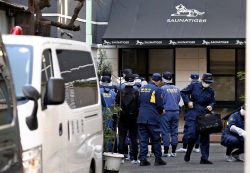12:20 JST, January 17, 2021
Jan. 17 marked 26 years since the Great Hanshin Earthquake, which killed 6,434 people. Communities’ redevelopment projects have finally shown signs of completion, but increasing costs from the long duration of the projects have become a new problem.
After the disaster, redevelopment projects have been carried out at six locations in Hyogo Prefecture. One is still underway to the south of Shin-Nagata Station in Kobe. As shopping streets in the area were devastated, the municipal government decided on a plan two months after the disaster to build 44 mid- and high-rise buildings by fiscal 2003.
However, the completion of the project is expected to be delayed to fiscal 2023 due to difficulties in discussions with landowners and others. In one of the largest redevelopment projects, on which ¥230 billion has been spent, only half the shop owners have returned. Due to such factors as decreased land prices, the project is unlikely to achieve profitability.
The city government’s assessment of the project said it was a problem that the project had not brought back the area’s vitality. This is a clear indication of the difficulty of redeveloping a community that has been badly damaged. This should be used as a lesson for future disaster recovery efforts.
In the wake of the Great Hanshin Earthquake, disaster prevention measures have progressed in many parts of the nation.
At the time of the disaster, about 310,000 people took refuge in about 1,100 evacuation centers at its peak. Many people fell ill due to the crowded conditions and cold weather. Subsequently, the government compiled guidelines in an effort to prevent disaster-related deaths and called for thorough hygiene management.
In recent years, cardboard beds that protect the body from the cold of the floor and also protect privacy have been widely introduced, in efforts to improve the quality of living during evacuations.
Currently, the spread of the novel coronavirus is forcing a rethink of evacuation environments.
During the torrential rains in Kyushu last July, which occurred in the midst of the pandemic, the capacity of evacuation centers was drastically reduced. Each family was separated by two to three meters, and partitions were installed. Infection control at evacuation centers has become a challenge for each local government.
When Typhoon No. 10 approached Kyushu in September last year, some shelters exceeded capacity as residents rushed in.
From now on, it is important to disperse evacuation sites. The central and local governments need to make sure that people know that hotels, inns and the homes of acquaintances are also options. It would also be effective to inform the public through websites how crowded evacuation sites are.
Since the Great Hanshin Earthquake, the number of volunteers in disaster-affected areas has increased, but the pandemic has made it difficult for volunteers to travel across prefectural borders, limiting their activities. For the time being, there is expected to be a shortage of volunteers in times of disaster. In such cases, it will be important for people to support each other within the community.
Cooperation between local governments, nonprofit organizations and social welfare councils is progressing. It is recommended that they meet on a regular basis to clarify the division of roles in the event of a disaster, such as removing debris and operating evacuation centers.
— The original Japanese article appeared in The Yomiuri Shimbun on Jan. 17, 2021.
"Editorial & Columns" POPULAR ARTICLE
-

Violations of Subcontract Law: Major Automakers Must Eliminate Old Practices
-

Local Governments’ Tax Revenues: Devise Ways to Correct Imbalances in Tax Sources
-

5 Japanese Business Dinner Mistakes to Avoid — and What They Taught Me About Business in Japan
-

Heavy Rains in Asia: Support for Victims, Flood-Control Measures Urgently Needed
-

Rice Coupons: A Misguided Approach to Countering Rising Prices
JN ACCESS RANKING
-

Keidanren Chairman Yoshinobu Tsutsui Visits Kashiwazaki-Kariwa Nuclear Power Plant; Inspects New Emergency Safety System
-

Imports of Rare Earths from China Facing Delays, May Be Caused by Deterioration of Japan-China Relations
-

University of Tokyo Professor Discusses Japanese Economic Security in Interview Ahead of Forum
-

Tokyo Economic Security Forum to Hold Inaugural Meeting Amid Tense Global Environment
-

Japan Pulls out of Vietnam Nuclear Project, Complicating Hanoi’s Power Plans





















